Database of luminescent minerals
TOPAZE
Chemical formula: Al2SiO4(F,OH)2
Family: Silicates
Status: IMA-GP
Crystal system : Orthorhombic
Display mineral: NON
Luminescence:
Longwave UV (365nm) colors: |
Orange , Yellow , Orangy yellow , | ||
Shortwave UV (254nm) colors: |
Yellow , Yellowish White , Pale Yellow , Greenish white , | ||
Daylight picture
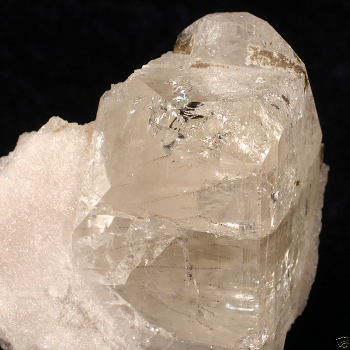
TOPAZE
Photo and Copyright: Bill Barr
Used with permission of the author;
Shortwave (254nm) picture
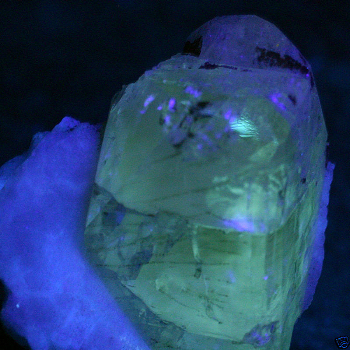
TOPAZE under SWUV
Photo and Copyright: Bill Barr
Used with permission of the author;
Pictures Galery:
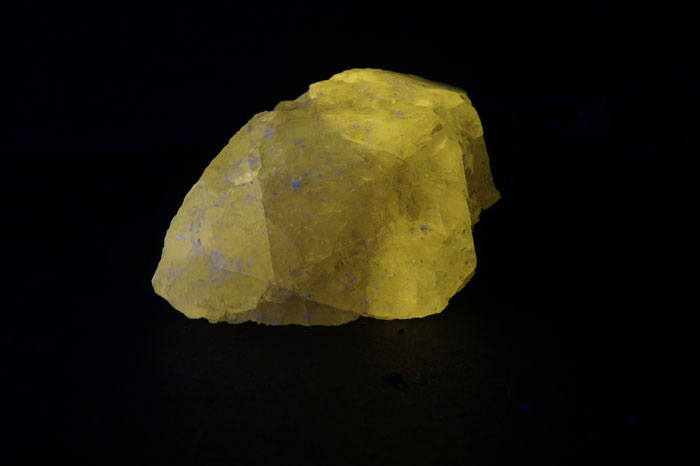


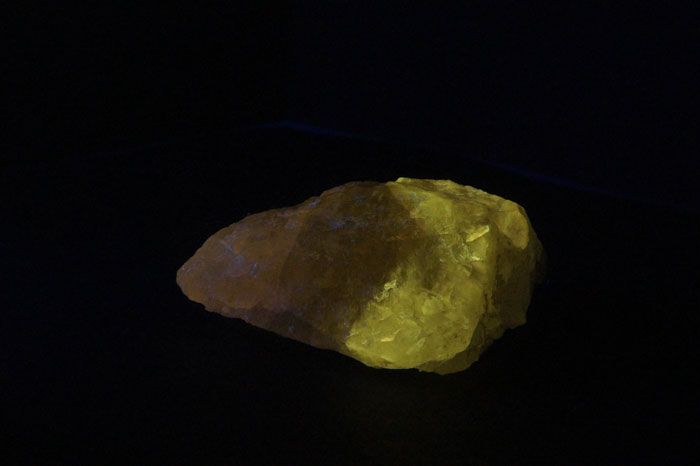 ...
...Do you have a photo of this mineral you would like to see in the gallery? Contact us!
Phosphorescence (in the common sense of the term) observable with the naked eye:
No phosphorescence visible to the naked eye under any type of UV
Thermoluminescence: OUI
Activator(s) and spectrum:
Activator(s): TiO6, Cr3+,
Peaks in the spectrum (nm):
TiO6 : broad band peaking at 455nm Cr3+ : lines at 680, 684, 695 - 697, 711, 734nm
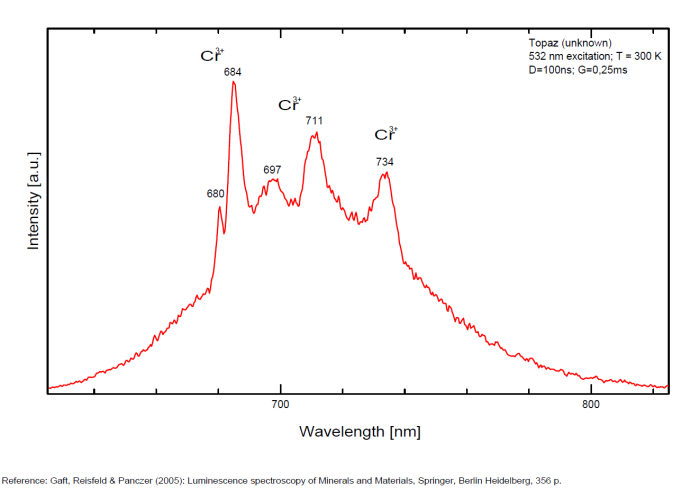
Spectrum: Michael Gaft, Petah Tikva, Israel. Plot: Institute of Mineralogy, University of Vienna, Austria, with permission of the authors.
Spectrum Galery:


 ...
...Comments on spectrum and activators:
Broad band peaking at 455 nm (TiO6). lines at 680, 684, 695-697, 711, 734 and band peaking near 680 nm, both due to Cr3+ It is established by Tarashchan that all photoluminescence characteristics of variously colored topazes from Ouro Preto, Brazil are due to three structurally non-equivalent Cr3+ centers isomorphically substituting Al3+ in the topaz structure and forming [CrO4F2]7−, [CrO4OH,F]7−, and [CrO4(OH)2]7− complexes. (Source: Luminescence spectroscopic study of Cr3+ in Brazilian topazes from Ouro Preto by A. N. Tarashchan and Al. see below). Laser-induced time-resolved technique enables to detect three different Cr3+ and possibly Mn4+ and (TiO4) emission centers (Gaft et al. 2003a)
Best localities for fluorescence (*):
- Shengus, Haramosh Mts., Skardu District, Gilgit-Baltistan, Pakistan (LW: yellowish or bright orange, SW: greenish white or bright yellow)
- Mine de Vermelhão, Saramenha,Ouro Preto, Minas Gerais, Brazil (very weak or laser induced red,Cr3+);
- Schneckenstein, former DDR, Germany (SW weak Yellow/green (De Ment));
- Boise Co., Idaho, USA (Yellow-orange);
- Zapot Topaz Mine, Zapot pegmatite, Gillis Range, Fitting District, Mineral Co., Nevada, USA (yellow LW);
- Teixerinha Mine, Itinga, Minas Gerais Brazil (06-07/2006, zoned fluorescence SW);
(*)The data are not exhaustive and are limited to a few remarkable localities for fluorescence
Bibliographic reference for luminescence:
- The Henkel Glossary of Fluorescent Minerals, Dr. Gerhard Henkel, Published by the FMS, 1989 ,
- Fluorescence: Gems and Minerals Under Ultraviolet Light, Manuel Robbins, 1994, Geoscience Press, ISBN 0-945005-13-X ,
- The World of Fluorescent Minerals, Stuart Schneider, Schiffer Publishing, 2006, ISBN 0-7643-2544-2 ,
- Luminescence Spectroscopy of Minerals and Materials, M. Gaft, R. Reisfeld, G. Panczer, Springer Editor, ISBN: 10 3-540-21918-8 ,
- Handbook of Fluorescent Gems and Minerals, a practical guide for the gem and mineral collector, Jack de Ment, 1949 ,
Reference for luminescence on the Internet:
- Luminescence spectroscopic study of Cr3+ in Brazilian topazes from Ouro Preto by A. N. Tarashchan; M. N. Taran; H. Rager; W. Iwanuch, Physics and Chemistry of Minerals, Volume 32, Number 10 / janvier 2006 (pp. 679-690).
- Time-resolved luminescence of Cr3+ in topaz Al2SiO4(OH,F)2, M. Gaft, L. Nagli, R. Reisfeld, G. Panczer, M. Brestel, Journal of Luminescence Volumes 102–103, May 2003, Pages 349–356
- UV-Waves September/October 1996, UV Minerals in former East Germany by H.J.Weller and J. Slacik reprinted from Fundgrube, XXVI, 1990,#3
Images:
- Shengus, Skardu District, Gilgit, Pakistan LW: https://www.mindat.org/photo-818295.html
- Shengus, Skardu District, Gilgit, Pakistan SW: https://www.mindat.org/photo-818296.html
- Shengus, Skardu District, Gilgit, Pakistan various specimens: https://www.mindat.org/photo-818797.html
Mineralogical reference on the Internet:
 http://www.mindat.org/show.php?name=Topaze
http://www.mindat.org/show.php?name=Topaze
 http://webmineral.com/data/Topaze.shtml
http://webmineral.com/data/Topaze.shtml
Internet Search:
 Image search on 'Google Images'
Image search on 'Google Images'
 Search for documents in all languages on Google
Search for documents in all languages on Google
A request providing no result means only that no such reference exists in the database, but it does not mean that what you are looking for does not exist, just not to our knowledge. If you think you have found an error or omission, please let us know via the contact page being sure to cite the source of information.

